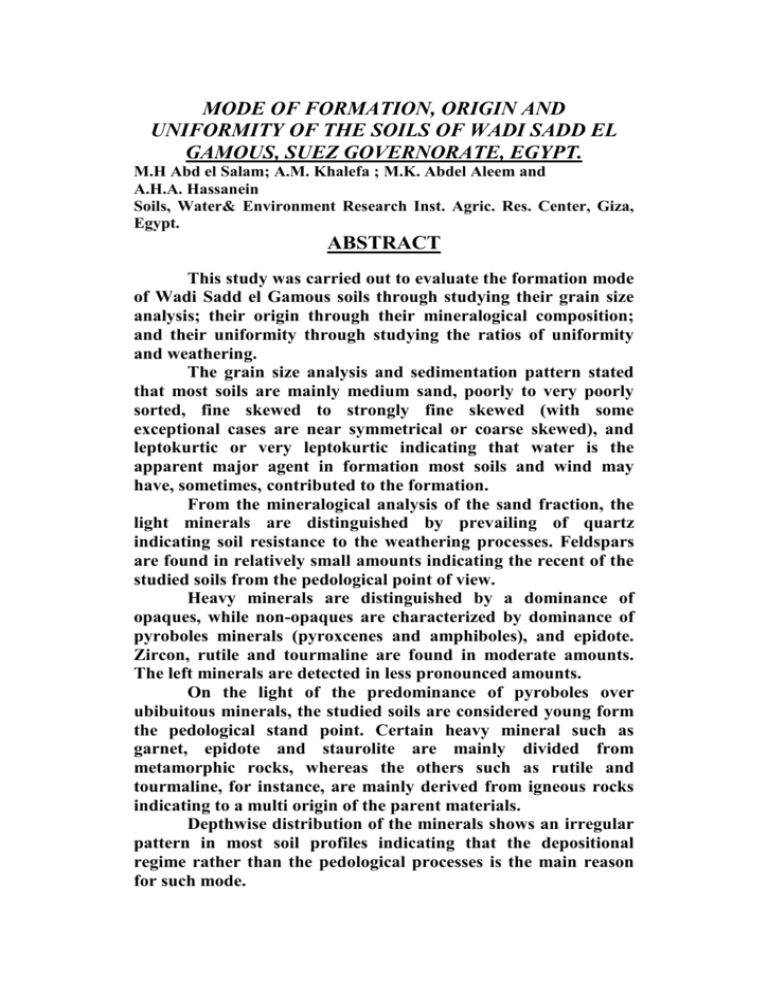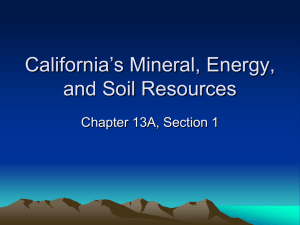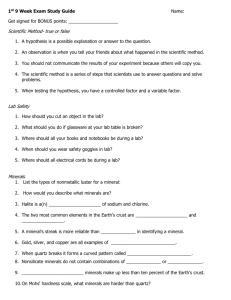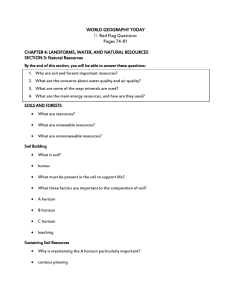mode of formation, origin and uniformity of the soils of wadi sadd el
advertisement

MODE OF FORMATION, ORIGIN AND UNIFORMITY OF THE SOILS OF WADI SADD EL GAMOUS, SUEZ GOVERNORATE, EGYPT. M.H Abd el Salam; A.M. Khalefa ; M.K. Abdel Aleem and A.H.A. Hassanein Soils, Water& Environment Research Inst. Agric. Res. Center, Giza, Egypt. ABSTRACT This study was carried out to evaluate the formation mode of Wadi Sadd el Gamous soils through studying their grain size analysis; their origin through their mineralogical composition; and their uniformity through studying the ratios of uniformity and weathering. The grain size analysis and sedimentation pattern stated that most soils are mainly medium sand, poorly to very poorly sorted, fine skewed to strongly fine skewed (with some exceptional cases are near symmetrical or coarse skewed), and leptokurtic or very leptokurtic indicating that water is the apparent major agent in formation most soils and wind may have, sometimes, contributed to the formation. From the mineralogical analysis of the sand fraction, the light minerals are distinguished by prevailing of quartz indicating soil resistance to the weathering processes. Feldspars are found in relatively small amounts indicating the recent of the studied soils from the pedological point of view. Heavy minerals are distinguished by a dominance of opaques, while non-opaques are characterized by dominance of pyroboles minerals (pyroxcenes and amphiboles), and epidote. Zircon, rutile and tourmaline are found in moderate amounts. The left minerals are detected in less pronounced amounts. On the light of the predominance of pyroboles over ubibuitous minerals, the studied soils are considered young form the pedological stand point. Certain heavy mineral such as garnet, epidote and staurolite are mainly divided from metamorphic rocks, whereas the others such as rutile and tourmaline, for instance, are mainly derived from igneous rocks indicating to a multi origin of the parent materials. Depthwise distribution of the minerals shows an irregular pattern in most soil profiles indicating that the depositional regime rather than the pedological processes is the main reason for such mode. The index figure of the studied soils does not appear a specific pattern with depth with quite differences from one layer to another indicating a multi depositional regime. From the irregular trend of uniformity ratios and weathering ratios, the soils under study seem to be formed by multi origin and/or multi depositional regime along the course of sedimentation. INTRODUCTION Horizontal expansion of agricultural land is one of the major aims in agricultural. To prove this goal, the basic informations that required putting reclamation plans must be available. These informations related to soil origin, mode of its formation and its uniformity. To gain this point, the current study aims at evaluating of soil physical, mineralogical and pedological properties of soils of Wadi Sadd el Gamous to elucidate their mode of formation, identify the minerals within the sand subfraction and their relation to soil origin and development as a degree of uniformity of parent materials. To demand the genesis and mode of soil formation, particle size distribution of the soils was taken as a criteria basis. In this regard, Hammad (1968) stated that application of grain size analysis in the field of soil science may be appropriate using the size frequency distribution within the non clay part of soil, would give assessment of sedimentation and stratification of soil material. In this work, statistical treatment of the distribution pattern of the non-clay fraction was carried out using parameters sited by Folk and Ward (1957). In these parameters, the cumulative percentages were plotted against particle diameter expressed as phi (Φ) unit using special probability papers, where Φ= -log (d)/log 2, and (d) is the diameter in mm. These parameters are; A) Sorting expressed as standard deviation (σI), B) Skewness (SkI), C) kurtosis (KG) and D) Average grain size expressed as Median (MZ). In the respect of evaluating the soil origin and its uniformity, one of the concept that may be recommended as a criterion for this regard is the mineralogical composition and sand fraction as assemblage of mineral frequencies and ultra stable ratios (Haseman and Marshall, 1945; and Barshad, 1964). MATERIALS AND METHODS Wadi Sadd el Gamous lies on eastern desert closed to the Bitter Lakes (Fig. 1). This area bounded by latitudes 30° 12 to 30° 15 North, and longitude 32° 20 to 32° 24 East, and cover about 4000 feddans. This study was carried out taking into consideration three main geomorphic unites were detected from this investigation; outwash plain, alluvial plain, and wadi plain (fig. 1). Eleven soil profiles have selected to represent the aforementioned three main geomorphic units. The soil profiles were morphologically described following FAO system (1990) Table (1). Thirty-six soil samples were collected, air-dried, sieved through 0.2 mm sieve and subjected to the following analyses: The physical analyses were carried out according to Black (1965) and Jackson (1967). Grain size distribution was performed by dry sieving for coarse texture samples (Piper, 1950), and by the pipette for the fine texture (Black, 1965). The results of mechanical analysis were represented graphically on probability paper using the phi (Φ) notation and from these, the statistically parameters were evaluated according to equations of Folk and Ward (1957). Nine soil profiles representing the major geomorphic units prevailed the area under consideration were chosen for mineralogical study. Separation of heavy and light minerals of the fine sand fraction ((0.125 – 0.063 mm) was carried out according to the procedures outlined by Brewer (1964). Bromoform (Sp.gr. 2.850 ± 0.020) was using as a separating agent. After separation, the heavy and light minerals grains were washed with ethanol alcohol, dried and mounted on slices for microscopic inspection using canda balsam. Heavy and light minerals were symmetrically identified by the polarizing microscope as described by Kerr (1959), Milner (1962) and Brewer (1964). The graduated mechanical stage was used for counting of 500 grains as suggested by Krumbien and Pettijohn (1938) and Milner (1962). Table (1) RESULTS AND DISCUSSION 1. Grain Size Analysis and Sedimentation Pattern: Results of the mechanical analysis (Table2) are plotted on phi (Φ) curves (figs. 2, 3 and 4). Seven accumulative percentages (Φ5 ,Φ16 ,Φ25 ,Φ50 ,Φ75 ,Φ84 and Φ95) are recorded graphically for each sample, Table (3) then four statistical parameters (σ1 , SkI, KG and Mz) are calculated using the formula of Folk and Ward (1957) Table (3). These values indicate that: 1.1 Mean Size (Mz) Data in Table (3) show that the samples of different profiles fall between medium sand to very fine sand since Mz values range form 1.13 to 2.9 Φ. It is clear that there is no specific pattern throughout entire depth where in some profiles there is increase in the particle size with depth such as profiles 1, 4, 7 and 8 and the vise versa was observed in profiles 6, 9 and 10, while there is no specific trend in the other profiles . 1.2. Sorting (σ1) Sorting data in Table (3) reveal that sediments of all profiles are either poorly sorted or very poorly sorted sediments through their entire depth where standard deviation (σ1) values lie between 1.15 and 2.76 Φ indicating that the soils are deposited mainly by water action. 1.3. Skewness (Sk1) Values of skewness (sk1) indicate that most layers of all profiles are fine skewed or strongly fine skewed where their values vary from 0.1 to 0.75 Φ except that of the surface layer of profile (3) which is coarse skewed (-0.13 Φ). Also, there are some other exceptional cases which they are near symmetrical (the values lay between -0.02 and 0.09 Φ), these cases be founded in the top layers of profiles 2, 9 and 10, the subsurface layers of profiles 5, 7 and 11 and the deepest layer of profile 8. It is worth to mention that a curve with perfect symmetry has Sk1 value of zero. Positive values indicate a tail of fine materials (a tail to the right side in frequency distribution curve) i.e. positively skewed, i.e. fine skewed. Negative values indicate a tail of coarse materials (a tail to the left side in frequency distribution curve) negatively skewed, i.e. coarse skewed. Table (2) 1.4. Kurtosis (KG) Date of Kurtosis (Table 3) indicate that sediments constituting all profiles of the studied area are commonly leptokurtic or very leptokurtic (values of KG are between 1.15 to 2.72 Φ), except for the surface layer of profile 5 and the subsurface layer of profile 3 which kurtosis are platy kurtic (KG = 0.97 Φ) and extremely leptokurtic (KG = 3.42 Φ), respectively. It is worth mentioning that platy kurtic values indicate that water is the main factor responsible for soil formation, while leptokurtic and very leptokurtic values indicate involvement of wind and water in soil formation. Extremely leptokurtic values indicate that wind is the main factor responsible for soil formation. Accordingly, in spite of water being the apparent major agent in formation most soils, wind may have sometimes contributed to the formation. Table (3) 2. Soil Origin Contents and distribution of the residual minerals either inherited from the parent rock or altered during soil formation processes represent one of the most important tools in evaluating the soil profile uniformity and developments (Abd el Salam 2000, Shehata et al 2001 and Abd el Salam et al 2005). The study of these minerals in the sand fraction, in term, is indicative of the weathering status of minerals, losses and gains, as well as general processes involved in the various soil layers during soil formation. In this respect Haseman and Marshall (1945) stated that qualitative and roughly quantitative determinations of soil minerals are usually sufficient to establish its origin. 2.1. Light Minerals Data in Table (4) reveal that quartz mineral ranged from 93.5% to 96.5% of the light minerals of sand fraction in the studied soil profiles. Feldspars are considerably low being from 3.5 to 6.5 % with a relatively predominance of orthoclase then plagioclase, while microcline is the least. The vertical distribution of either quartz or feldspars does not portray any specific pattern with depth. The dominance of quartz over the other members of light minerals reflects its resistance to weathering during the multi cyclic processes of sedimentation (El-Naggar, 2004 and Abd el Salam et al 2005). This content may be also, originated or inherited from the parent material itself. The presence of feldspars could be taken as an indication of the weathering that prevailed during soil formation and evolution, which was not probably drastic to cause a complete decay of these minerals susceptible to weathering (Abd el Salam et al 2005). 2.2. Heavy Minerals 2.2.1. Opaque Minerals Frequency distribution of heavy minerals presented in Table (5) show that the main constituents are opaque minerals, which they are mostly iron ores such as hematite, ilmenite, limonite, magnetite and pyrite. Opaques range from 47.8 to 56.5% followed by pyroxenes (10.6 to 18.9%), amphiboles (8.7 to 15.7%) and epidote (2.7 to 6.5%). The relatively low values of opaque minerals characterize soils of alluvial plain (the mean values from 51.4 to 52.0%), while the high values are in soils of outwash plain with mean values between (52.9 to 53.9%). Table (4) Table (5) Depthwise distribution of opaque does not portray any specific pattern in all soil profiles except for the soils of profiles, 6, 8 and 11 where opaque tends to increase with depth and the vise versa in profile 8. 2.2.2. Non Opaque Minerals Other minerals include pyroboles minerals parametamorphic minerals, ubibuitous minerals; biotite, epidote and monazite Table (6) are present in subordinate amounts: a) Pyroboles The major part of the non-opaque minerals consists, essential, of pyroboles (pyroxenes and amphiboles). The pyroxene minerals are represented mainly by augite, diopside then hypersthenes, while amphiboles are mainly dominated by hornblende. Data in Table (6) show that pyroxenes as a hole constitute range from 24.4 to 37.6 % of the non-opaque. Generally, soils of alluvial plain (profiles 7 and 8) attain, relatively higher content of pyroxene. Augite is a dominant mineral followed by diopside and hypersthenes. Concerning the distribution of pyroxenes with depth, data in Table (6) show an irregular pattern in most profile except that of profiles 6 (wadi plain) and 10 (outwash plain). This indicates that sedimentation regimes rather than pedological processes were the main cause for such a mode. The abundance of pyroxenes indicates that the soils under study are young from the pedological point of view. Amphiboles are the second most abundant group of nonopaques after pyroxenes. They mainly present in the form of hornblende, while actinolite constitutes a small part of amphiboles followed by glucophane. The values of such group range from 19.7 to 30.2 % of the non-opaques. Soils of profile 9 (alluvial fans) have the higher content of amphiboles with mean values 26.9 %, whereas soils of profile 6 (wide plain) contain the lower content with mean value 21.2 %. In most profiles data show an irregular pattern of vertical distribution indicating that sedimentation regime rather than pedological processes was the main cause for such a mode. Generally, from the abundance of pyroxenes and amphiboles, which are considered to be less stable minerals, it is evident that the soils of Wadi Sadd el Gamous are relatively recent formed and are weakly developed. Table (6) b) Parametamorphic Minerals These minerals are mainly, represented by garnet, staurolite, kayanite, silimanite, andalusite, and they together constitute, relatively little portion (less than 11.5%) of the nonopaques. Data in Table (6) show that staurolite is the most common mineral in such group followed by garnet then silimanite and / or andalusite. The values of this group vary from one geomorphic uint to another with range between 7.2 and 11.3 % of the nonopaque in soils of profiles 1 and 4 (Wadi plain), respectively. Depthwise distributions of the minerals that represent such group indicate an irregular pattern in most soil profiles. c) Ubibutous Minerals This group of minerals is represented by zircon, rutile and tourmaline, which considered very stable minerals, and so they are taken as indicator to the degree of uniformity of soil parent materials. Presence of such resistant minerals in soils reflects the intensity of weathering and soil formation processes (Milner, 1962). Data in Table (6) show that contents of zircon, rutile and tourmaline vary from 8.5 to 15.4%, 2.4 to 6.4% and 2.9 to 5.7% of the non-opaques, respectively. The vertical distribution patterns of the resistance minerals show an irregular distribution throughout the entire profile depths. This pattern of resistant minerals reflects the multi origin of parent materials or their multi depositional course, or both. d) Other Minerals These minerals are mainly represented by biotite, epidote and monazite that their content ranged from 1.2 to 5.1%, 6.0 to 12.6% and 1.6 to 3.3% of the non-opaques, respectively. In addition, these minerals are presented in varied frequencies from one location to another as well as the tend of their distribution throughout the depth is not obvious; however, it is mostly irregular. From the former discussion it can be concluded that opaques, pyroboles, ubibuitous minerals and epidote are the most abundant mineral whereas the remaining minerals are found in less pronounced amounts. The variation of the mineralogical composition already observed in Table (6) could attribute to the sedimentation regime or/and the effect of sorting distribution (Harga et al 1983). From the pedological standpoint, the studied soils are considered young on the light of the predominance of pyroboles over ubibuitous minerals. Certain heavy minerals such as garnet, epidote and staurolite are mainly derived from metamorphic rocks, whereas the others such as rutile and tourmaline, for instance are mainly drived from igneous rocks indicating to the multi origin of the parent materials (Shendi, 1990). Index Figure Index figure is obtained from the ratio between heavy minerals and light ones (on weight basis). Data in Table (6) indicate that the values of the index figure of the studied soil profiles range between 0.8 and 4.9 with no specific pattern with depth. Quite differences of index figure from one layer to another indicating a multi depositional regime. 3. Uniformity of Soil Parent Materials To elucidate the homogeneity or heterogeneity of the soil parent material, resistant minerals as well as their ratio are employed (Haseman and Marshall, 1945). In this connection, the assumption ratios are Zircon/Rutile, Zircon/Tourmaline and Zircon/Rutile + Tourmaline; besides the weathering ratios stated by Hammad (1968) are taken as a criteria for profile uniformity and weathering sequence of the sediments. Application of the former ratios for each soil profile (Table 7 and figs. 5, 6, 7, 8, 9 and 10) indicate that in soil profiles 1 and 2 (Wadi plain) there is a stratification where the top two layers of each profile seemed to be formed from the same parent material and differ from the two deepest layers. In profile 7 (alluvial fans) the two middle layers have different values of indices from both surface and deepest layers indicating that both top and deepest layers seemed to be formed from the same parent material which differs from that of the two middle layers. As for the reminder profiles, it is clear from the irregular trend of uniformity and weathering ratios, the soils seem to be formed by multi-origin and/or multi-depositional regimes. These evidences confirm the heterogeneity of the soil parent materials. Table (7) In conclusion, the data of frequency distribution of resistant minerals and weathering ratios show that most soils constituting each profile are often heterogeneous (with some exceptional in profiles 1, 2 and 6) either due to their multi-origin or the subsequent variation along the course of sedimentation, and therefore, the soils under study are considered young from the pedological point of view. REFERENCES Abd el Salam, M.H. (2000). Pedological studies on some soils in North Sinai.Ph.D. Thesis, Fac. Agric., Moshtohor, Zagazig Univ., Egypt. Abd el Salam, M.H.; S.A. Abd Allah and Nemat I. Ghayad(2005). Origin, mode of formation and uniformity of the soils of Wadi el Shieh, Assiut Governorate. Egypt. J. of App. Sci., 20 (6A)No. 6 June pp. 293-312. Barshad, I. (1964). Chemistry of soil development. In: Bear, F.E. (Ed), Chemistryof the soil. pp. 1-70 Reinhold Publ. Crop., New York. Black, C.A. (1965). Method of Soil analysis. Part 1, Physical and Mineralogical properties. Including statistics of measurements and sampling. Amer. Soc. Agron. No. 9, Madison, Wisconsin, USA. Brewer, R. (1964). Fabric and mineral analysis of soil. John Wiley and Sons. Inc.New York. El- Naggar, M.A. (2004). Land evaluation of some soils in A.R.E. Ph.D. Thesis, Fac. Agric. Mostohor, Zagazig Univ., Egypt. FAO, (1990). Guideline for soil profiles description. FAO. International Soil Reference Information center, Rome. Folk, R.L. and W.C.A.Ward (1957). Brazas river bar: a study in the significance of grain size parameters. J. Sed Petrol. 27: 3-26. Hammad, M.A. (1968). Genesis of the soils of the Western Mediterranean coast of UAR. Ph.D. Thesis, Fac. Agric., Ain Shams Univ., Egypt. Harga, A.A.; H.A. El-Kady and A.A. Elwan. (1983). Mineralogy of the fine sand fraction and its relation to pedogenesis of Kharaga and Dakhla Oases. Egypt. J. Soil Sci. 23, No. 2, pp.145-153. Haseman, J.F. and C.E. Marsall (1945). The use of heavy minerals in studies of the origin and development of soils. Missouri Agric. Exp. Sta. Res. Bull.,387. Jackson, M.L. (1967). Soil chemical analysis. Prentice Hell, India private, LTD.,New Delhi. Kerr, P.F. (1959). Optical mineralogy. Mc Grow-Hill Book Co. Inc. New York. Krumbien, W.C. and F.J. Pettijohn (1938). Manual of Sedimentary petrography. Appleton – Century – Crofts, New York. Milner, H.B. (1962). Sedimentary petrogophy. George Allen and Unwin L.T.D., Museum St. London. Piper, C.S. (1950). Soil and plant analysis. Interscience Publishers, Inc. New York. Shehata, R.B.; O.A. Gobran and A.A. Khalil (2001). Genesis and mode of formation of some soils west of Suez canal, Egypt, Egypt. J. Soil Sci. 41.No. 3. pp 379-397. Shendi, M.M. (1990). Some mineralogical aspects of soil sediments with special reference to both lithology and environmental conditions of formation in Fayoum area. Ph.D. Thesis, Fac. Of Agric., Fayoum, Cairo Univ., Egypt. الملخص العربى: دراسة تكوين وأصل وتجانس أراضى وادى سد الجاموس محافظة السويس -مصر مصطفى حامد عبد السالم – عادل محمد خليفة – مصطفى قرنى عبد العليم – أحمد حسنين أحمد معهد بحوث األراضى والمياة والبيئة – مركز البحوث الزراعية – الجيزة – مصر. أجريت هذة الدراسة بهدف التعرف على كيفية تكوين أراضى وادى سد الجاموس من خالل دراسة التوزيع الحجمى لحبيبات التربة ،وكذلك االتعرف على أصلها من دراسة التركيب المعدنى لها ،والتعرف على مدى تجانسها من خالل دراسة نسب التجانس ونسب التجوية. ويمكن تلخيص النتائج المتحصل عليها فيما يلى: بالنسببة لكيفيبة تكببوين األرضبى فبببالرجوإ ىلبى التحليبل األحصببائى لنظبام التوزيببع الحجمى لحبيبات (الرمل و السلت) وبأستخدام القياسبات المقترحبة بواسبطة Folk & Ward عام 7591تبين أن معظم األرض تتكون من رمل متوسط الحجم ،وكانت أيضاّ poorly sortedىلببى very poorly sortedو Skewedىلببى ( strongly skewedمببع بعببض االسبتننااات والتببى كانببت near symmetricalأو (coarse skewedوكانببت االرض أيضباّ leptokurticأو very leptokurticمشببيرة ىلببى أن المبباا هببو العامببل األساسببى فببى نقببل وترسيب تكوين هذه األراضى مع وجود مساهمة للرياح أحياناّ فى عملية التكوين. اظهر التحليل المعدنى للرمل أن المعادن الخفيفبة تميبزت بسبيادة معبدن الكبوارتز مما يعكس المقاومة لعمليات التجويه ،كما كانبت الفلسببارات بنسببة قليلبة ممبا يشبير البى حدانة تكوين هذه األرض. تميبزت المعبادن النقيلببة بسبيادة المعبادن المعتمببة ،أمبا غيبر المعتمببة فقبد تميببزت بسبيادة معبادن البيروببول (البيروكسبينات واالمفيببوالت) واألبيبدوت .أمبا الزركبون والروتيببل والتورمالين فقد وجدت بنسبة متوسطة فى حبين أن المعبادن غيبر المعتمبة االخبرى فكانبت بنسبة أقل .وعلى ضوا سيادة معادن البيروبول عن معادن الزركون والروتيل والتورمبالين لوجبود معبادن مشبتقة مبن صبخور متحولبة يمكن القول أن األرض حدينبة التكبوين .ونظب اّر ّ منبل الجارنببت ،واالبيبدوث ،واالسببتروليت ،و خببرى مشبتقة مببن صببخور ناريبة منببل الروتيببل والتورمالين ،فهذا يشير ىلى تعدد مواد االصل. بصفة عامة أوضحت النتبائج أيضباّ عبدم انتظبام توزيبع المعبادن مبع العمب ممبا يدل على أن نظام الترسيب كان العامل األكنر تأني اّر فى تكوين هذه االراضى مبن العمليبات البيدولوجية .كما أوضحت نتائج ال index figureايضاّ تعدد عمليات الترسيب. وعموماّ فأنه من خالل دراسة توزيع نسب التجانس ونسب التجوية يمكن القبول أن األرض غير متجانسة ،وقد يرجع ذلك ىلى تعدد مادة االصل أو تعدد نظام الترسيب.






